My first post of this year briefly discussed my goal of doing 3,650 minutes of dry practice in 2019. These posts are mostly for my own accountability. I am releasing this as a normal Saturday post because I learned a lot during this two-week period. If you aren’t interested in my performance this year skip past my log and read the notes.
January 1 – 11: 200 minutes, January 12 – 31: 140 minutes
February 1 – 15: 140 minutes, February 16 – 28: 130 minutes
March 1 – 15: 160 minutes, March 16 – 31: 160 minutes
April 1 – 15: 140 minutes, April 16 – 30: 160 minutes
May 1 – 15: 140 minutes, May 16 – 31: 170 minutes
June 1 – 15: 180 minutes, June 16 – 30: 160 minutes
July 1-15: 150 minutes, July 16 – 31: 130 minutes
August 01: 10 minutes low-light presentation w/ Olight I3T
August 02: 10 minutes low-light presentation w/ Olight I3T
August 03: 10 minutes low-light presentation w/ Olight I3T
August 04: 10 minutes low-light presentation w/ ThruNite Archer 1A V3
August 05: 10 minutes low-light presentation w/ ThruNite Archer 1A V3
August 06: 10 minutes low-light presentation w/ Olight I3T
August 07: 10 minutes low-light presentation w/ Olight I3T
August 08: 10 minutes low-light presentation w/ Streamlight ProTac 2L-X
August 09: 10 minutes low-light presentation w/ Olight I3T
August 10: 10 minutes low-light presentation w/ Streamlight ProTac IL-AA
August 11: 10 minutes Type I malfunctions w/ Streamlight ProTac IL-AA
August 12: 10 minutes Type I malfunctions w/ Olight I3T
August 13: 10 minutes reloads w/ Streamlight ProTac IL-AA
August 14: 10 minutes reloads w/ Streamlight ProTac IL-AA
August 15: 10 minutes low-light presentation w/ Streamlight ProTac IL-AA
Monthly Target: 300 minutes
Monthly Actual To Date: 150 minutes
Cumulative Target: 2,430 minutes
Cumulative Actual to Date: 2,310 minutes (38 hours, 30 minutes)
Focus Areas
I spent this entire period working with a handheld flashlight in low/no light. Instead of getting up and out super early, I used a room in my basement that doesn’t have a window. My learning curve sky-rocketed on day one and it seemed like I added some thoughts to this post nearly every day of this session. This was one of the best two-week sessions I’ve done in a while.
I admit that I have been procrastinating practicing these techniques. A reader email a month or so ago spurred me into action. He’d shot a copperhead at night, and mentioned he was looking forward to my practice routine for low-light. I’m now sorry I waited so long to improve this gap in my skills.
LIghts
Part of putting this off was my difficulty with light selection. I don’t use a weapon-mounted light on my carry gun, so this practice necessitated a handheld. I have pocket-carried a flashlight for years. The one I’ve carried, and my carry method, have little “tactical” utility, however. When I began this period I wasn’t sure if I wanted to commit to belt-carrying a flashlight in a combo light/mag pouch, or carry a pocket-clipped light on my weak side.
After reading Grant Cunningham’s recent thoughts on flashlights I’ve become much more thoughtful about light selection (which is probably the opposite of the point of his articles), but that’s another, much longer story for another time. In the meantime I’ve purchased several “EDC” lights this month. Unfortunately, I still haven’t found a light that balances my personal ideals of size, usefulness as a defensive tool, and day-to-day utility.
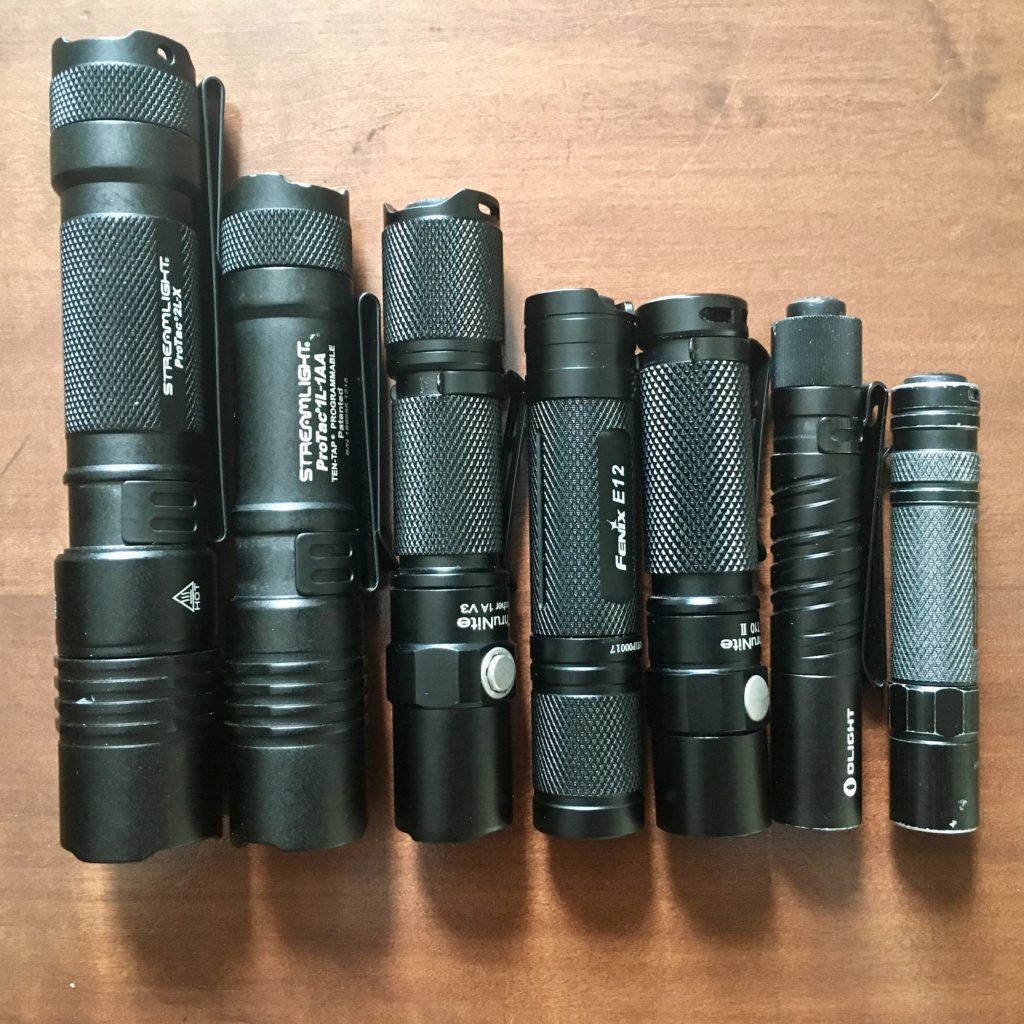
Instead of waiting until I found the perfect light, I decided to temporarily accept a compromise solution and get to work. I grabbed an Olight I3T single-AAA light the I already owned. It has a clip and a tail switch which makes it suitable for working basic defensive technique. It’s a great all-around light, but it’s probably not the “right answer” for defensive use. For developing the basic technique while I looked for a better light, it was fine. Maybe think of it as the .22 of flashlights.
I worked with a bunch of other lights during this period. Some came close, but honestly none worked quite as well as the little Olight. I’m sure self-defense experts will make fun of me for using such a tiny light, but as I discovered, bigger lights have some problems, too.
Light Selection Lessons Learned
I don’t want to get too far down the rabbit hole on equipment. Practice will tell you what is important in your equipment, and practice matters way more than equipment. I did learn a few things about my gear during this period, though.
First, the size of the light matters. I tried working with what would be accepted as a true “self defense” light. It is the Streamlight ProTac 2L-X. Holding 2 CR123 batteries and throwing 500 lumens, it is too large for my to carry comfortably. More importantly, I found that I had a tendency to drop it if I had to manipulate the gun’s slide (i.e. while clearing malfunctions). Its barrel was just too large for me to reliably hold onto with my left pinky and ring fingers.
I also found that I had a tendency to drop even smaller lights that were slick. This was one issue with the Streamlight ProTac IL-AA. With slightly sweaty hands I would drop it occasionally. Because the pocket clip is fairly tight, I would also occasionally lose control of it pulling it out of my pocket at speed. This is partially technique; this happened far less frequently the more I worked with this light. With lights of similar size dropping the light wasn’t a factor at all, though and I would definitely prefer a knurled body.
I found that the ThruNite Archer 1A V3 was a near ideal light. The form factor is excellent. It offers all of the features and modes I would like in a light.. Unfortunately mine is terribly unreliable and will not turn on sometimes.
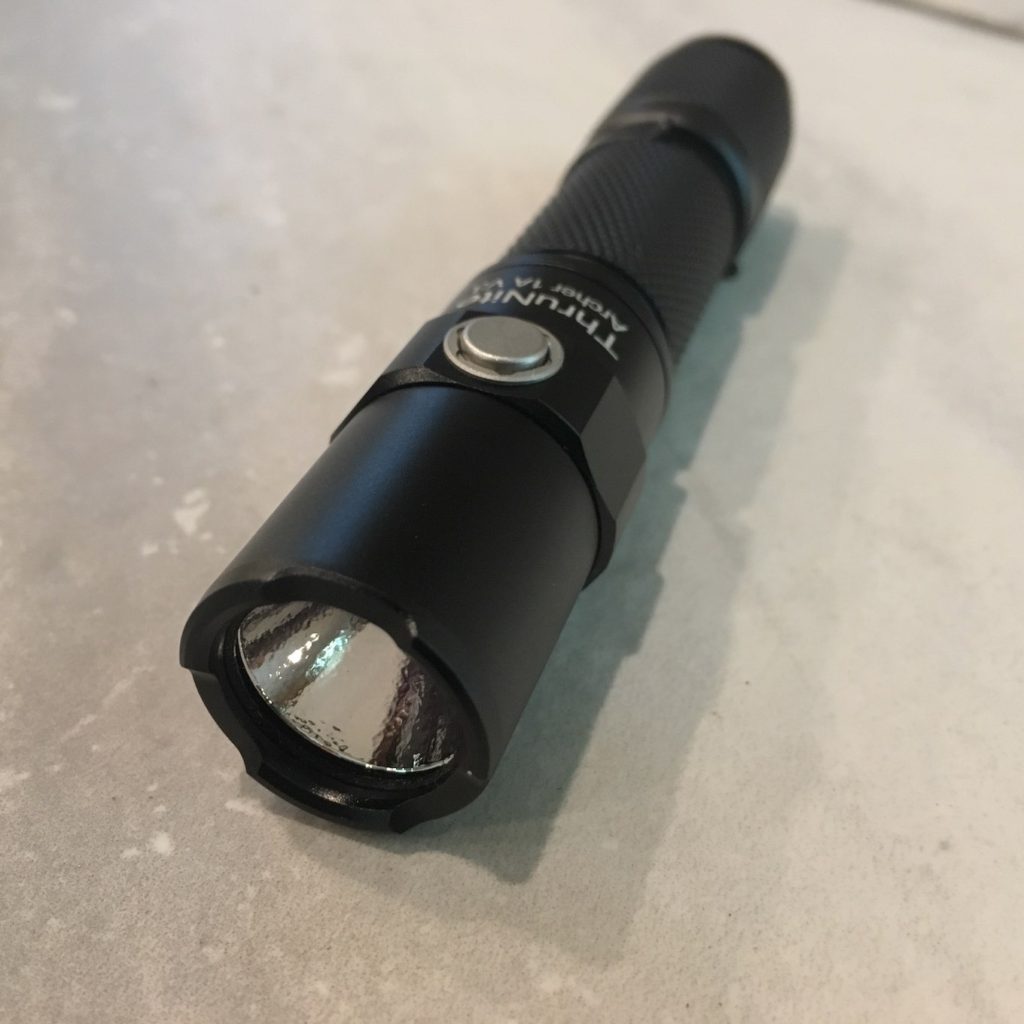
If there are any flashlight nerds on here, hit me up. I’d love some help finding a light that meets my criteria. So far the two closest things I’ve found are the Streamlight and the ThruNite Archer 1A V3, but there are compromises with both. The world of EDC flashlight options is vast, and absolutely bewildering to me.
Guns
Most of my work was, predictably and practically, with my EDC gun. I had to fly during this period, so I spent five days working with something else. To be fair, I’ve never had an issue flying with firearms, and I’ve flown with them a lot. The biggest issue I ever had was arriving at an airport too early to check my bag. Still, I’m not quite ready to trust TSA and baggage handlers with my custom 1911. I can’t afford to replace it, so I’m not going to expose it to that kind of risk. Instead, I took one of the most replaceable guns in American right now: my M&P9 Shield.
Presenting with a Handheld
The first few days of this period were just spent getting acquainted with drawing and shooting with a handheld light. I’m glad I’ve gone in the order I’ve chose this year; drawing the gun is functionally no different than a SHO draw. I really appreciate the SHO work I’ve already put in – I’ve myelinated that pathway pretty well. I worked the presentation in conjunction with a light in two ways.
First, I worked on presenting the gun with the light already out and on. If a light is used, it may very well be because I’ve noticed something that has caused me to pull out my light and investigate. This was just a SHO draw with my light in my left hand. Not much new here.
Secondly, I spent about half of my time simultaneously drawing the light and the gun. It is also possible that I may recognize something as a serious threat without knowing exactly what it is. In this case I don’t want to draw one, then the other.
Simultaneously drawing the light with my left hand and the gun with my right was a “pat your head/rub your stomach” thing at first. It didn’t take long to get in the groove, though. By the end of the second or third session I had it down pretty well. I also spent a minute or two at the beginning and end of each session maintaining two-handed draws. I don’t want to sacrifice recency-of-experience on that critical skill.
the “Eye Index” Technique
I played with a few handheld light techniques. And truly, I only “played” with all of them except one. I messed around with the FBI, Harries, and Ayoob’s update on the Chapman technique. The one I like the most and practiced almost exclusively is the eye index technique.
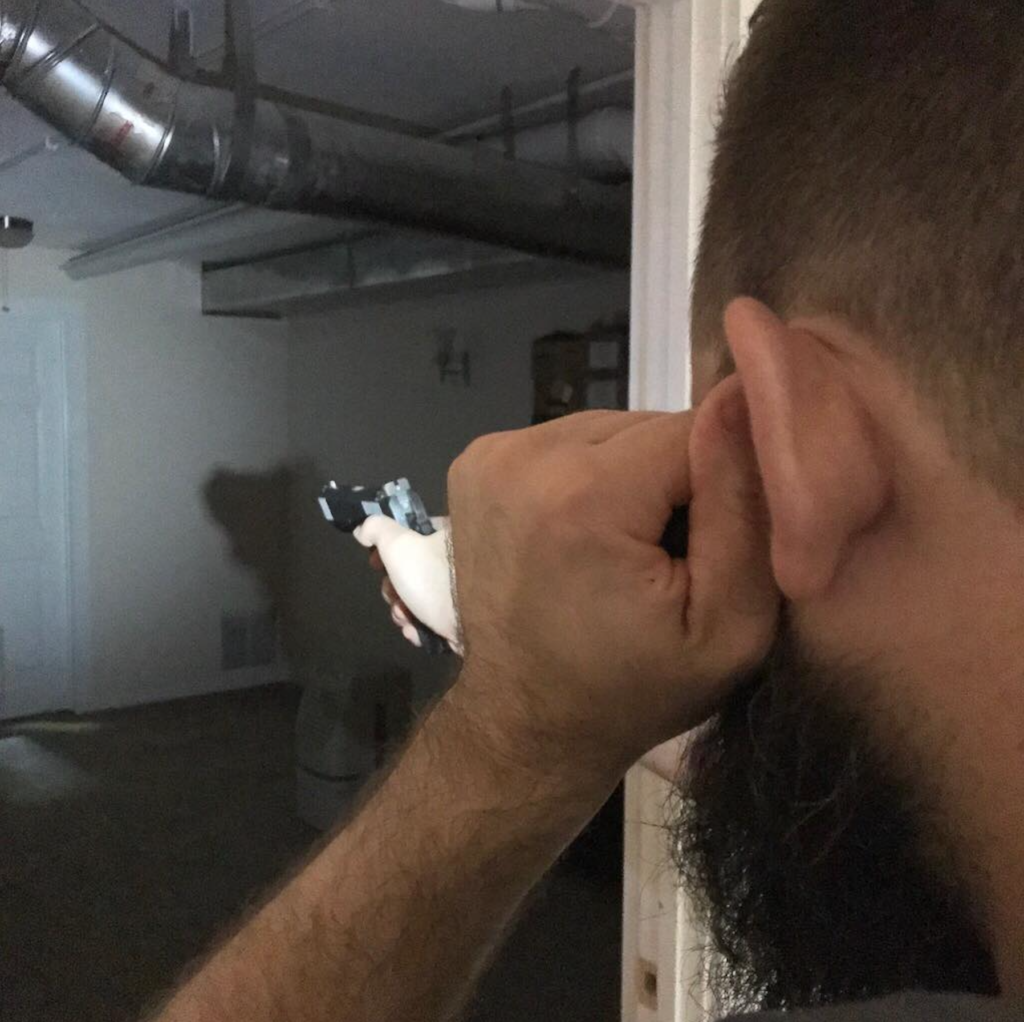
Though this technique is probably espoused by a lot of other trainers, Mike Seeklander is the person I see pushing this the hardest. I initially came across it in his book, Your Defensive Handgun Training Program. I’ve since seen him demonstrate it. His justification for it makes a lot of sense to me, so I’m going with it. That doesn’t mean I won’t work to learn some of the others in the future, but this is the one I want my brain to pull off the stack if I need to use a handheld light and a gun at the same time.
the Light Isn’t Just for Shooting
As I mentioned earlier, I learned a ton during this period. Most of my low-light shooting was done when I was in a gun-carrying job when I had WMLs on both my rifle and pistol, and a Surefire on my belt. Almost none of my military/paramilitary low-light training focused on concealed carry. I have spent very little of my own time working these techniques.
Additionally, in the military/paramilitary context, light is used extremely sparingly. White light “NDs” (negligent discharges) were serious offenses. Light can ruin night-adjusted eyes, give away your position, or blow a soft infil.
As a citizen self-defender, white-light discipline is – let’s just be honest with each other, I haven’t gone on many raids lately and most likely, neither have you – probably not that important after the threats are neutralized. Quite on accident I discovered that the white light can protect me from another possible threat: shooting myself while holstering.
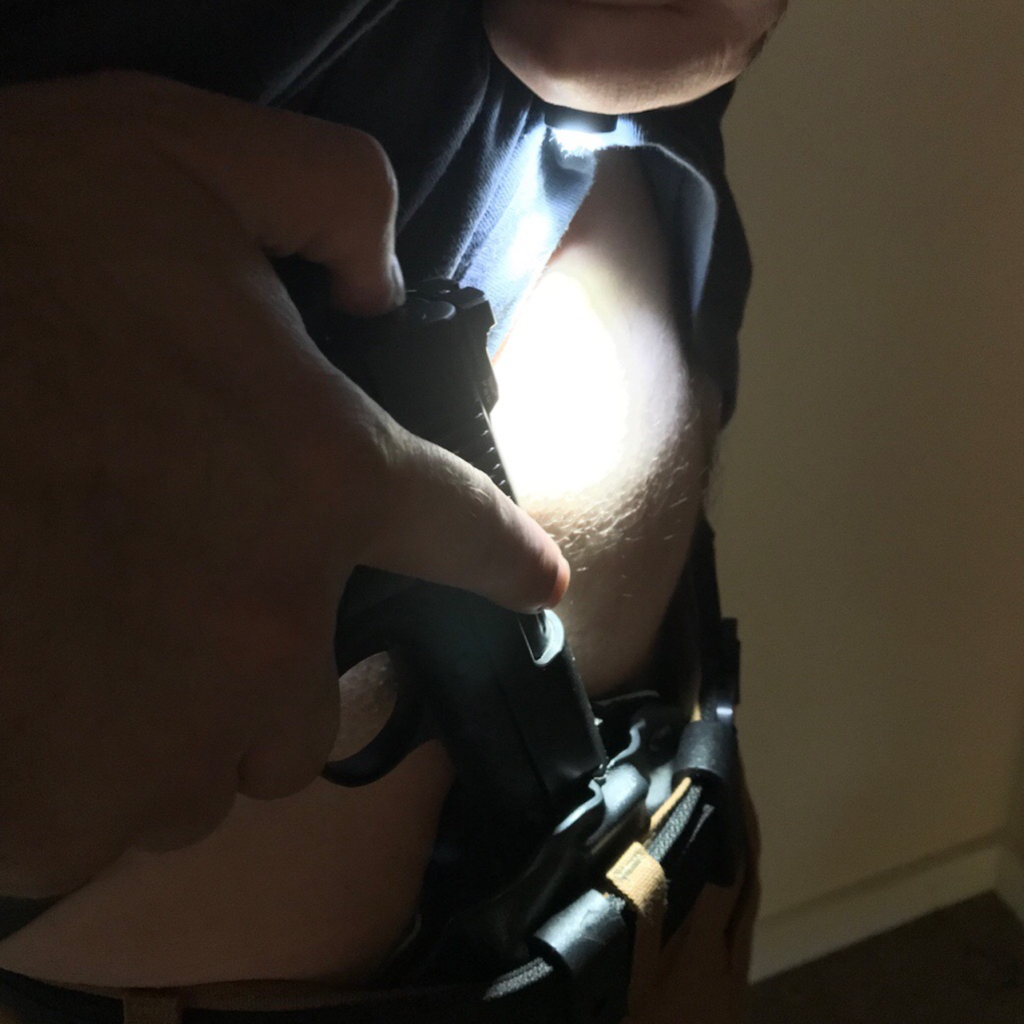
I’ve never heard this addressed in an article about low/no-light shooting: the light can help you “look” your gun back into the holster. I’m sure it’s out there, but I haven’t run across it, or more likely haven’t noticed it. When pulling my cover garment back up to expose/clear the holster, the light is still in my hand. With the ice-pick grip it is still pointed downward, giving me an unobstructed view of the holster.
This is a huge reason to carry a handheld light. The use of a handheld light in a self-defense shooting is extremely unlikely because most areas are at least somewhat illuminated. At night, if you are in a shadow, this light may not be sufficient to safely holster. A handheld flashlight allows you to get the gun back into the holster safely in reduced/low/no-light conditions.
Malfunctions & Reloads
Though I primarily worked on presentation, I also did a little bit of work on malfunctions. Use of firearms in defensive conditions seems to induce malfunctions a bit more often than range conditions. When you are moving extremely fast under stress, you may acquire a sub-optimal grasp, inadvertently activate controls, foul the slide, etc. It makes sense to me to be very skilled at clearing malfunctions.
When using a handheld light you have a couple options. First, you can clear the malfunction strong-hand-only. This is not ideal; it is slower and more mistake-prone than two-handed malfunction clearance. It is even possible for one-handed clearing to induce a worse malfunction, like when clothing covers the ejection port, or you don’t get a full rack.
Another option is to simply drop the light and clear the malfunction two-handed. This is problematic because now you have to recover the light, and you may not have the light you need to adequately clear the malfunction. Some lights come with or can be retrofitted with finger rings near the tail cap. These allow you to “drop” the light but still retain it.
The third option is to try to clear the malfunction with two hands while retaining the flashlight. Lacking a light with a retention ring, this is what I practiced. This is where I really saw how much the size and design of the flashlight matter.
I also spent a couple days working reloads with the light in my left hand. I was surprised that it wasn’t massively more difficult than normal reloads. It was probably slower, though. It did occur to me that now I’m getting into super-outlier territory: one-handed shooting, with a light, and having to reload. Like I’ve said before, I have 365 days of dry practice to fill and it doesn’t actually hurt me to run through these scenarios occasionally.
The Bottom Line
If you’ve never spent an appreciable amount of time practicing with a handheld light – or haven’t recently – you might want to. Seems easy, maybe it is easy, but it’s not easy if you haven’t worked at it.
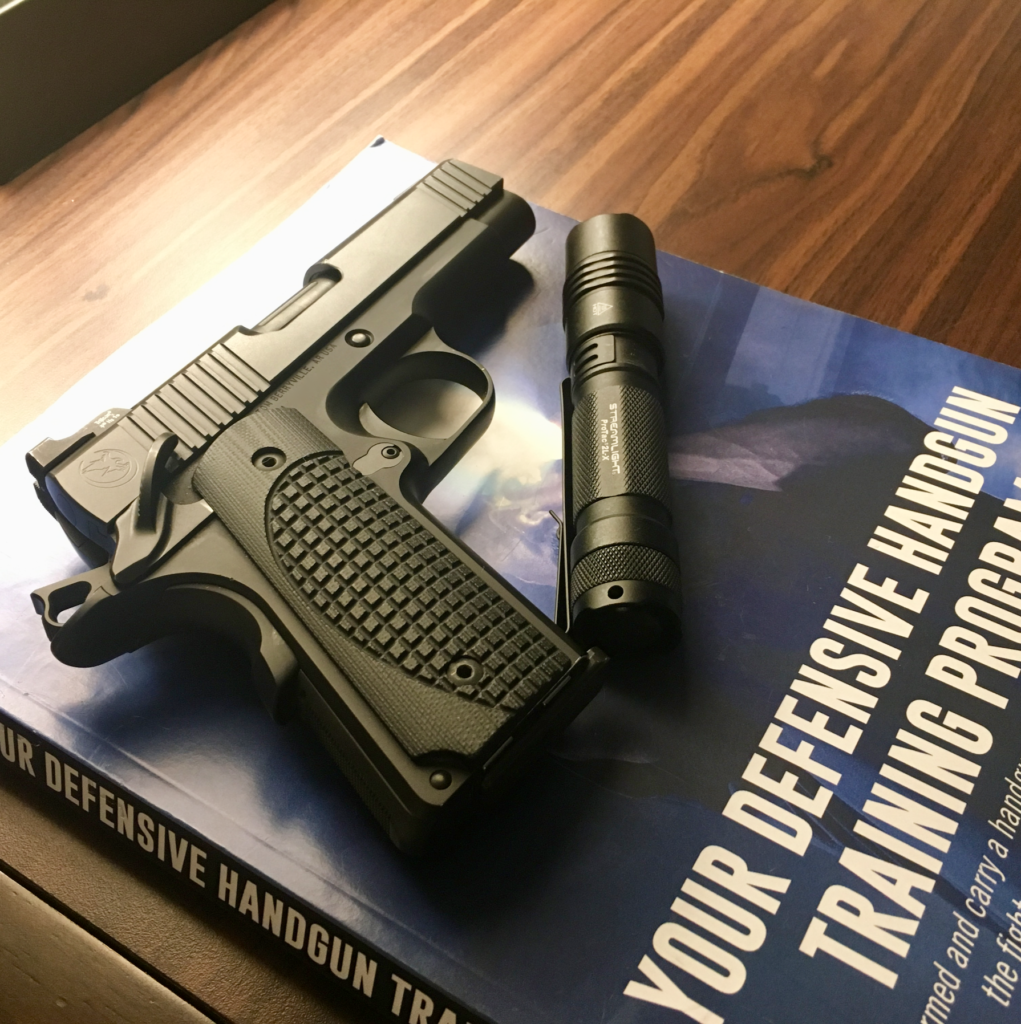
Like anything else, you can get analysis paralysis trying to find the perfect combination of tool and technique. I recommend you pick something and myelinate it. Don’t waste a bunch of time like I did waiting for a hardware solution to come along. Find the 80% solution. Then do the work.
If you aren’t dry practicing. . . WHY NOT? It’s not hard to find 10 minutes a day to dry practice, and it’s COMPLETELY FREE. Take ten minutes you’d be spending vegging out on Instagram or in front of the TV and turn it into a tangible skill.

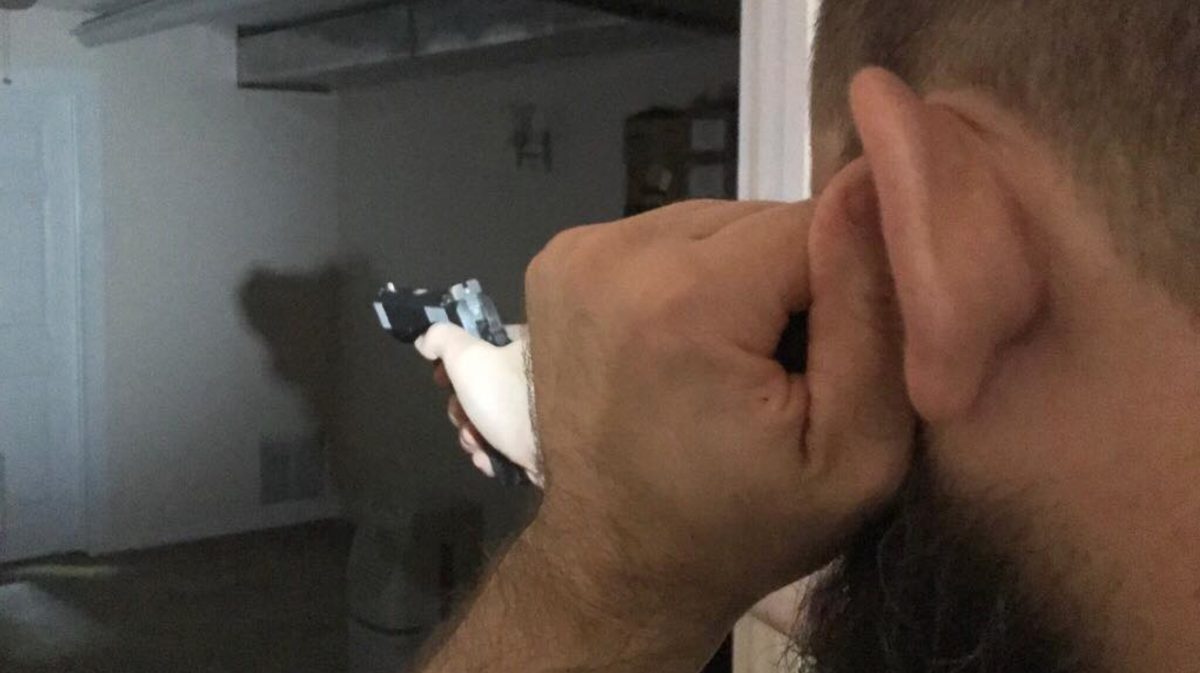
Thank you for running this. I had to shoot a second Copperhead at night last week. Fourth one shot at my feet this year, not including the one who got away, after it bit one of our livestock dogs. Black snakes are scarce for some reason here this summer. The seem to keep venomous snakes away.
I found that holding the light beside my revolver was okay, but the front light tube did not glow much. I do not carry a semi, but I found a malfunction anyhow. In my short barrel guns, CCI snake shot capsules jump forward under recoil. That locks up the gun. Luckily, a single shot stops a “crawlie.”
I am going to practice with the index-eye hold as well as with my support hand, as I train for one-handed work.
No advice on lights. My wife and I both like Streamlight products. Both our lights are big for EDC.
I really like the eye-index position because it does shed light on your sights. You might or might not see the light tube glow (at least, I have had mixed results with that), but it will definitely help you see the sight. You can definitely see that in Justin’s picture above.
Greyson is right – this does shed good light on the sights. My illustration in that photo is poor; I usually have the light up higher, closer to my temple. I’m really liking the eye-index, despite the need for one-handed shooting.
Great post and a good reminder of the breadth of skills that dry fire practice can (and should) cover.
Like you, I’ve tried lots of different EDC lights, looking for the ‘perfect’ option. There is a lot that I like about the Streamlight 1L-1AA, but I also find the barrel a bit too thick, and I wish it offered more than 350 lumens. I’ve also carried an Olight M1T off and on for the last year – I really like the light quality, but find that with the tail switch not being shrouded, it would accidentally turn on when clipped in my pocket way too often.
I’ve finally settled on a Fenix PD-25 and it ticks all the boxes for me. Good gnurling/grip, 550 lumens on high, a shrouded tail switch and it’s smaller/slimmer than the Streamlight mentioned above. It also has the option of running off a 16340 rechargeable Li-ion (included) or 3V CR123A.
For the nightstand, I use a Fenix PD-35 with a Thyrm Switchback on it. Once you get used to the techniques involved with using the Thyrm, it’s an excellent addition, allowing for really secure use of the light, and essentially hands-free when needed without losing retention.
But enough about the gear. What this post highlights is that whatever light option you end up with, you need to practice with it – both standalone and in conjunction with your firearm. Only with practice will shortcomings in your equipment choices and your techniques be revealed, and using the two items in conjunction may not be as intuitive as one assumes, esp. under duress.
Hammer,
Excellent point about training/mission driving gear. I didn’t really know what would and wouldn’t work for me until I got out and worked with it. I hate to admit it, but this was a huge shortcoming in my abilities. That statement doesn’t just apply to flashlights, either. This speaks to getting out and working with whatever you’re going to depend on.
I own the Streamlight equivalent to that little Olight. That seems like a handy size, but I had trouble with it. It just only fits in my hand so it was easy to grasp it so that the heel of my hand was partially blocking the beam. I also carried it in my back pocket and found that it would work its way up and out of the pocket occasionally. I also had issues with the outside bend of the pocket clip getting caught on my seat belt which was one of those weird things that shouldn’t happen, but did (though I had a very hard time deliberately reproducing it).
I changed to the Streamlight Stylus 2AAA light. It is slick, so it might not work for you, but the longer length avoided issues with blocking the beam or having it work out of a pocket (to be fair, it will still occasionally work up and fall into the pocket, but it always falls in because of the length, so I don’t risk loosing it). The pocket clip doesn’t have the second bend, so it doesn’t catch on stuff. Also, with a 2AAA light, I can put it in my mouth sideways if I [want to feel like a pirate or] need my hands completely free. The down side is that it is only 100 lumens, which isn’t a whole lot by today’s standards. Still, it is about the same as an incandescent 4D Mag-Lite in a size I will actually carry.
I don’t know if I qualify as a flashlight nerd, but I am curious to see what your light selection experiences are. I don’t really like multiple modes (and despise mode-switching being tied to the tail cap), so it sounds like we might have some slightly different criteria, but I suspect it will still be informative.
I’ll let you know as soon as I figure out what my criteria are, haha! I thought I knew, but the journey of this two weeks has me rethinking a couple things (what can I live with, what can I live without). Currently I’m carrying the Streamlight ProTac 1L-AA. It has some great features.
One feature it is lacking is modes; I am almost guaranteed to use my light daily in some sort of non-defense context, and almost guaranteed to never use a handheld light in self-defense, so I am biased to lights that have good utility. Ideally a light would have a “high” mode that I could access instantly from the tail switch, and a low that is low enough to read by without washing out the page. Something in between would be cool, but those are the ones I’d like. It seems like you either get a very defense-oriented light, or one that has 16 different modes to toggle through.
Anyhow…I’ll probably update some light selection stuff in the future.
One other thought: one thing I absolutely DO NOT need is a strobe. For some reason this feature appears on a lot of the lights out there.
Completely agreed. What I would really like to find is a 2AAA sized light with a low and high output that has a momentary/constant tail switch like my Streamlight and that adjusts between the two brightness settings using a rotating head like the Fenix E05. I don’t want strobe or SOS, and I don’t want my tail switch to do anything other than turn the light on. Some of the lights are going to the side-of-the-head buttons like that ThruNite to control modes and I might be okay with that as long as the side button doesn’t turn on the light (my dad has one where the battery is constantly dead because the side button gets hit while it is in his belt pouch) and can’t accidentally change modes while the light is in my pocket.
Since I haven’t found that, I just stick with a single light setting and hold it between my thumb and middle finger (middle finger over the lens as an impromptu red lens) when I need low light (usually looking for something in the dark without waking up my kids.
Normally I don’t comment but I’ve completely changed the way I teach and use a flashlight over the last 10 yrs or so.
I have come to embrace the modified “SF Neck index” up to my cheek. I played with it higher but it makes you vulnerable to flank attacks from the light side since your peripheral vision is obstructed to a degree.
My favorite light is the somewhat new SF “Stiletto” (I hate that name). I first thought it was dorky and looked like a Star Trek Phaser. But the flat design and clip allows it to be clipped IWB comfortably, pocket, hat bill (used that quite a bit). Mode 2 locks out stupid strobe. Rechargeable means you use it with impunity not worrying about it being dead for the real deal. The “fuel gauge” tells you when you need to plug it in. The mostly plastic body makes it lightweight. The over ride tactical button gives you a flood of 600 lumens covering about 3 people standing side to side from 3-5 yards.
I truly underestimated how much I like this light and how much more I would use a rechargeable light for menial tasks.
Dean, GREAT to see you here in the comments. Thanks for sharing your valuable opinion. I like a jawbone index, too, and find I do better shooting with one hand than I do with a compromised “two-handed” grip that results from trying to juggle light and gun at the same time.
I just carry a Fenix E11. Not super bright, but bright enough. About the size of a chap stick tube.
You know, this is funny timing. I was just looking over an AAR from a low-light pistol training class and was considering the weapon-mounted vs separate light discussion. I’ll admit I don’t practice nearly enough for low light circumstances, but it really does require consideration. There are pros and cons to both sides.
You mention the dance of drawing the pistol and light at the same time being tricky. How does that work with also clearing the cover garment?
Matt,
I practice SHO draws pretty regularly, so adding in a light really made no difference in relation to the cover garment. The light is clipped in my left pocket, so the garment doesn’t affect it at all. The mental “confusion” came in because usually during the draw/presentation I’m ONLY drawing/presenting. I think this might be the first thing I’ve done where I’m adding another task while drawing. If you’ve got your draw well-myelinated/automated, it’s not a huge hurdle as you can just “let the draw happen” and use your mental energy to focus on getting the light out to support it. Hope that answers your question!
Justin